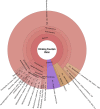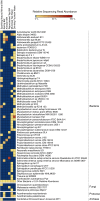A comparative analysis of drinking water employing metagenomics
- PMID: 32271799
- PMCID: PMC7145143
- DOI: 10.1371/journal.pone.0231210
A comparative analysis of drinking water employing metagenomics
Abstract
The microbiological content of drinking water traditionally is determined by employing culture-dependent methods that are unable to detect all microorganisms, especially those that are not culturable. High-throughput sequencing now makes it possible to determine the microbiome of drinking water. Thus, the natural microbiota of water and water distribution systems can now be determined more accurately and analyzed in significantly greater detail, providing comprehensive understanding of the microbial community of drinking water applicable to public health. In this study, shotgun metagenomic analysis was performed to determine the microbiological content of drinking water and to provide a preliminary assessment of tap, drinking fountain, sparkling natural mineral, and non-mineral bottled water. Predominant bacterial species detected were members of the phyla Actinobacteria and Proteobacteria, notably the genera Alishewanella, Salmonella, and Propionibacterium in non-carbonated non-mineral bottled water, Methyloversatilis and Methylibium in sparkling natural mineral water, and Mycobacterium and Afipia in tap and drinking fountain water. Fecal indicator bacteria, i.e., Escherichia coli or enterococci, were not detected in any samples examined in this study. Bacteriophages and DNA encoding a few virulence-associated factors were detected but determined to be present only at low abundance. Antibiotic resistance markers were detected only at abundance values below our threshold of confidence. DNA of opportunistic plant and animal pathogens was identified in some samples and these included bacteria (Mycobacterium spp.), protozoa (Acanthamoeba mauritaniensis and Acanthamoeba palestinensis), and fungi (Melampsora pinitorqua and Chryosporium queenslandicum). Archaeal DNA (Candidatus Nitrosoarchaeum) was detected only in sparkling natural mineral water. This preliminary study reports the complete microbiome (bacteria, viruses, fungi, and protists) of selected types of drinking water employing whole-genome high-throughput sequencing and bioinformatics. Investigation into activity and function of the organisms detected is in progress.
Conflict of interest statement
The authors declare the follow potential conflicts of interest with respect to the research, authorship and/or publication of this article: RRC is the founder of CosmosID, Inc., Rockville, MD and also a Professor at the University of Maryland; NAH and SMR are employees of CosmosID, Inc., Rockville, MD; JAC is the founder of Joseph Cotruvo and Associates LLC, Washington, DC; MBL is an employee of Essential Environmental and Engineering Systems, Huntington Beach, CA. The specific roles of these authors are articulated in the ‘author contributions’ section. This does not alter our adherence to PLOS ONE policies on sharing data and materials, as detailed online in the guide for authors (https://journals.plos.org/plosone/s/competing-interests).
Figures






Similar articles
-
Microbial community of municipal drinking water in Hangzhou using metagenomic sequencing.Environ Pollut. 2024 Feb 1;342:123066. doi: 10.1016/j.envpol.2023.123066. Epub 2023 Dec 2. Environ Pollut. 2024. PMID: 38048871
-
Unravelling the composition of tap and mineral water microbiota: Divergences between next-generation sequencing techniques and culture-based methods.Int J Food Microbiol. 2020 Dec 2;334:108850. doi: 10.1016/j.ijfoodmicro.2020.108850. Epub 2020 Aug 29. Int J Food Microbiol. 2020. PMID: 32919261
-
The River Ruhr - an urban river under particular interest for recreational use and as a raw water source for drinking water: The collaborative research project "Safe Ruhr" - microbiological aspects.Int J Hyg Environ Health. 2016 Oct;219(7 Pt B):643-661. doi: 10.1016/j.ijheh.2016.07.005. Epub 2016 Jul 14. Int J Hyg Environ Health. 2016. PMID: 27495908
-
Betaproteobacteria are predominant in drinking water: are there reasons for concern?Crit Rev Microbiol. 2019 Sep-Nov;45(5-6):649-667. doi: 10.1080/1040841X.2019.1680602. Epub 2019 Nov 5. Crit Rev Microbiol. 2019. PMID: 31686572 Review.
-
Microorganisms populating the water-related indoor biome.Appl Microbiol Biotechnol. 2020 Aug;104(15):6443-6462. doi: 10.1007/s00253-020-10719-4. Epub 2020 Jun 12. Appl Microbiol Biotechnol. 2020. PMID: 32533304 Free PMC article. Review.
Cited by
-
Sub-MIC antibiotics influence the microbiome, resistome and structure of riverine biofilm communities.Front Microbiol. 2023 Aug 1;14:1194952. doi: 10.3389/fmicb.2023.1194952. eCollection 2023. Front Microbiol. 2023. PMID: 37593545 Free PMC article.
-
Metagenomic Profile of Microbial Communities in a Drinking Water Storage Tank Sediment after Sequential Exposure to Monochloramine, Free Chlorine, and Monochloramine.ACS ES T Water. 2021;1(5):1283-1294. doi: 10.1021/acsestwater.1c00016. ACS ES T Water. 2021. PMID: 34337601 Free PMC article.
-
Specific Pathogen Free - A review of strategies in agriculture, aquaculture, and laboratory mammals and how they inform new recommendations for laboratory zebrafish.Res Vet Sci. 2021 Nov 20;142:78-93. doi: 10.1016/j.rvsc.2021.11.005. Epub 2021 Nov 20. Res Vet Sci. 2021. PMID: 34864461 Free PMC article. Review.
-
Microbiome Analysis for Wastewater Surveillance during COVID-19.mBio. 2022 Aug 30;13(4):e0059122. doi: 10.1128/mbio.00591-22. Epub 2022 Jun 21. mBio. 2022. PMID: 35726918 Free PMC article.
-
Comparative microbial metagenomic analysis of drinking water plants and wastewater treatment plants in Istanbul.Front Microbiol. 2025 Jan 20;16:1488268. doi: 10.3389/fmicb.2025.1488268. eCollection 2025. Front Microbiol. 2025. PMID: 39901928 Free PMC article.
References
-
- WHO. Progress on Drinking Water, Sanitation and Hygiene. Launch version July 12 Main report Progress on Drinking Water, Sanitation and Hygiene. Geneva; 2017.
-
- Cotruvo J. Legionella, Legionellosis, and Regrowth of Microorganisms in Drinking Water Quality and Contaminants Guidebook. First CRC Press; 2018.
-
- United States Environmental Protection Agency. Drinking Water Requirements for States and Public Water Systems: Revised Total Coliform Rule and Total Coliform Rule. 2013 [cited 3 Oct 2019]. Available: https://www.epa.gov/dwreginfo/revised-total-coliform-rule-and-total-coli...
Publication types
MeSH terms
Substances
Grants and funding
LinkOut - more resources
Full Text Sources
Medical
Miscellaneous

